Written by Marie Hoff with photography by Paige Green except as noted
Shearing is that unique seasonal dance between human and fiber animal. It’s the act that offers us wool and fine fibers to wear, knit, and sleep upon. But for people outside the agricultural sphere, shearing can appear as a cause for confusion or even concern. To learn more about this critical step in the process from soil to skin, Marie Hoff explored the age-old tradition between fleece and garment. In part one, we explore the history of sheep shearing and in part two, we learn more about the shearing process. We invite you to join us in a three-part series on shearing, moving through questions, considerations, and toward transparency and greater understanding of the processes that clothe us. This is the third installment of a three-article series on sheep shearing and animal welfare.
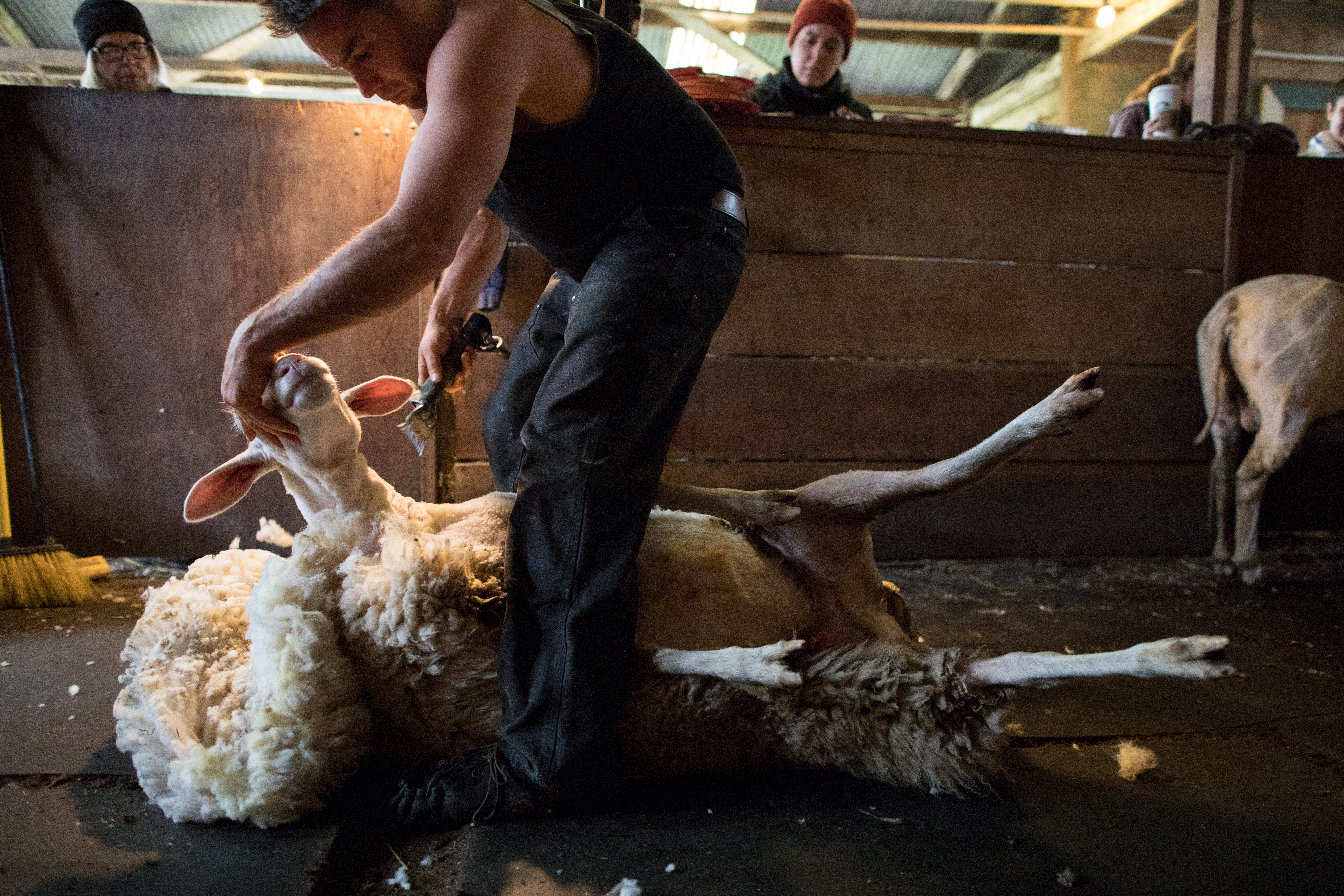
To understand the process of shearing animals, one must realize that sheep are less like adult humans deciding to get a haircut, and more like young children going to the dentist. Except that sheep are between 150-250 pounds, have hard hooves, and sometimes horns. Shearing is standard healthcare for sheep and other fiber animals, such as alpacas, some goats, and angora rabbits; in the first article, we explored more about why sheep need to be sheared.
Shearing sheep can be dangerous for both the shearer and the sheep alike: if a sheep gets spooked and starts to kick, it puts the shearer at risk of injury as well as the sheep. Shearing schools teach proper ways to hold sheep in order to keep them calm and safe, in addition to being able to shear efficiently so the sheep does not spend more time in the shearing process than necessary. This article will dive deeper into the process and choreography involved in transferring wool from sheep to garment, revealing the connections between people and the land we inhabit by way of the act of shearing.
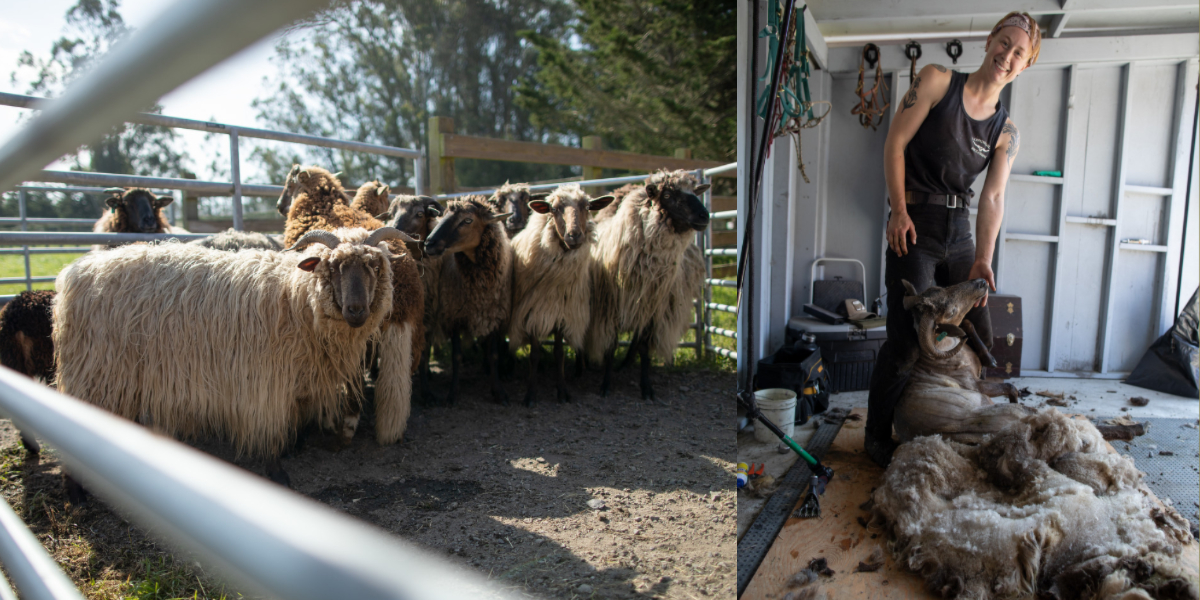
Many people do not grow up around sheep, unlike say dogs or cats. There are expectations and etiquette surrounding the way people treat sheep, just the same as there are for dogs and cats, but for sheep, the practices can be slightly different. Sheep do not ordinarily respond to whistles like a dog, nor do they tend to enjoy pats on the top of their head like dogs or cats do. When people are familiar with sheep, they know to scratch it under its chin (if it’s a reasonably docile sheep) rather than to pat it on the head. The reason for this etiquette is that sheep have a bucking instinct, which patting on the top of the head can trigger. One way to tell whether someone is familiar with handling and approaching sheep is if they go to scratch the chin instead of pat the head.
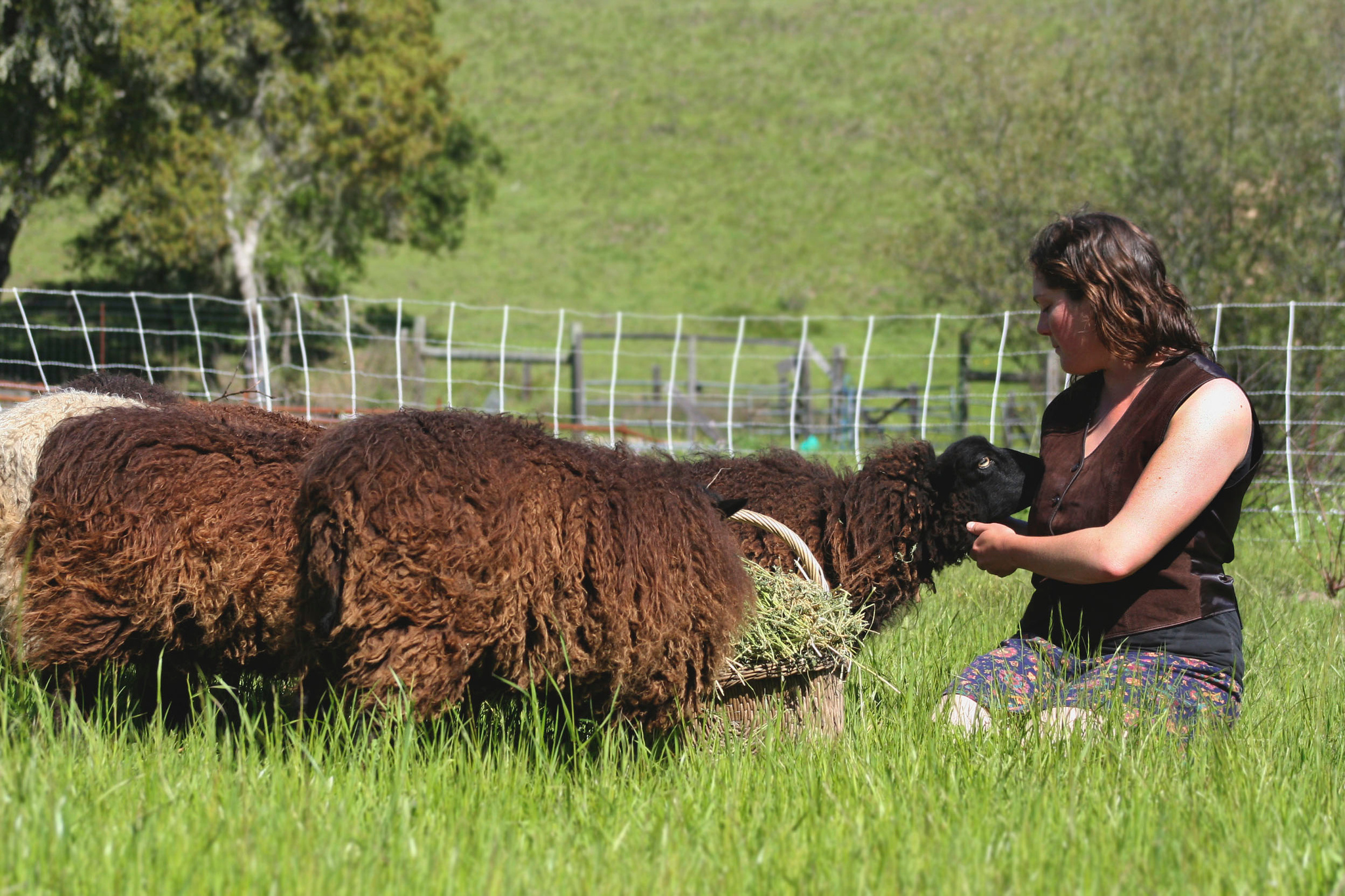
Flipping sheep, or turning them over so they are sitting on their rear, is also widely accepted and standard practice, though it can be surprising or alarming to people who haven’t spent much time with sheep. Stephany Wilkes, a sheep shearer, and author of Raw Material: Working Wool in the West, talks about how she lets her new clients know she is about to flip the sheep, and why, before she does it, in case they are unfamiliar with this practice.
She shared that she often narrates her actions: “I am going to flip the sheep over so I can shear its belly and crutch area, very important for sheep health. This looks rougher than it actually is. I lightly hold the sheep’s jaw and turn its head toward its shoulder. This naturally leads the sheep to try to sit down. When it begins to do that, I basically help the sheep down to the floor by pulling its hip toward me. Once it’s safely supported by the floor, I finish turning the sheep over. You may see me make some adjustments: if the sheep is overweight or pregnant, I may lean it back further to distribute weight more evenly, and push less against the diaphragm.”

Once flipped, sheep will tend to lean on one hip or the other, which makes sense because too much direct weight on the tailbone can be harmful. Standard practice is to keep animals from sitting directly on their tailbone. When you watch a sheep being shorn, the shearer is always making sure that the sheep’s tailbone is stacked in an S-curve, so their weight is not on the tailbone.
The mark of an experienced shearer is that the sheep are calm. And sheep are calm if they are held comfortably, with weight off their tailbone, spine organized in spiral or S-curve positioning, and a firm squeeze to hold their shoulders in place.
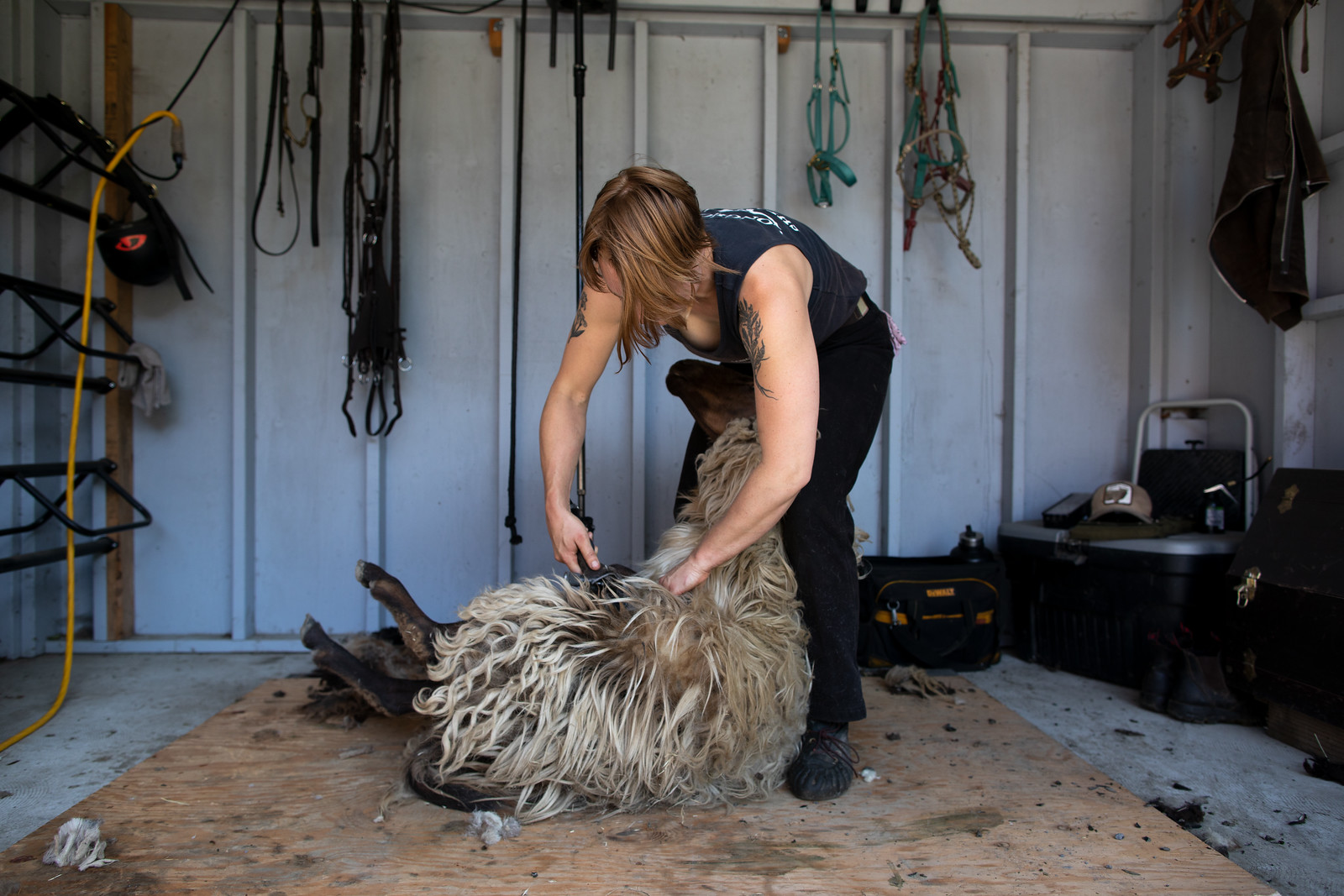
Another practice that people often find surprising is when sheep are dragged on their rear to move them into place for shearing. But once you learn to do it, you realize it doesn’t strain the animal, and is an ergonomic way to move a 150-250 pound animal a short yet exact distance.
The shearer then sets up the sheep facing a particular direction in relation to the shearing machine. Each position the shearer and sheep take are specific and repeated in exactly the same way as precisely as possible every time. There are several different patterns that shearers use in their dance with the sheep, but the one most commonly used in California is Bowen Technique, developed by Godfrey and Ivan Bowen in New Zealand.
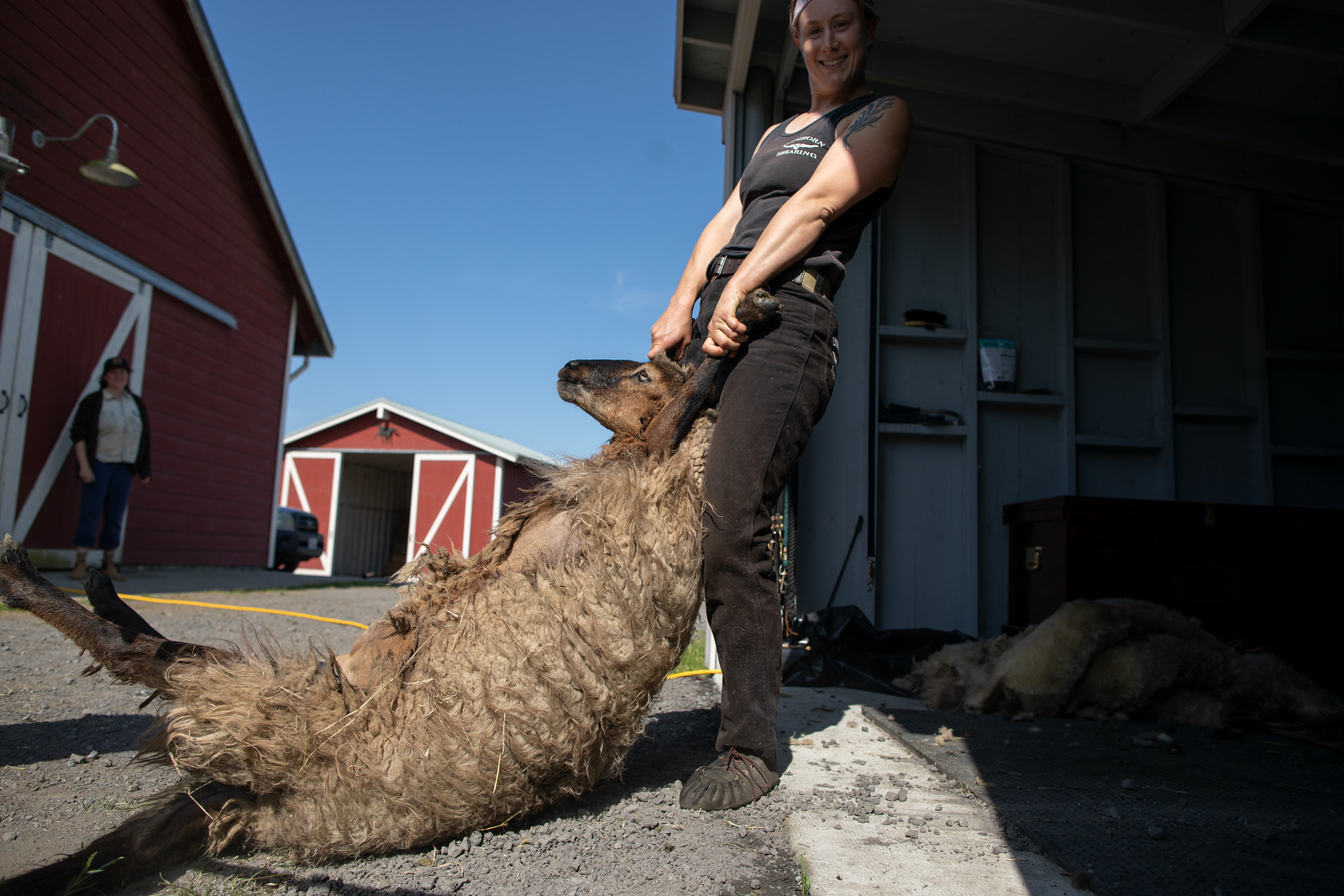
The first move is to shear the sheep’s chest, starting on the right. The shearer then works down the abdomen and belly, along the outside of the right hind leg, then traces along the inside of the right hind leg, across the crotch, and along the inside of the left hind leg. These movements are all done while holding the sheep in the stacked, upright, S-curved spine position. Once finished, the underside of the sheep is shorn and clean, however it’s really rare that this wool is useful for clothing because it is short and muddy or full of grass seeds and hay. The “belly wool” or “tags” are often discarded or used for mulch or erosion control material, and it is important to keep the belly wool separate from what will go into clothing, otherwise the mud and grass from the belly wool could get mixed into the clean wool and become so difficult to remove later on that the usable wool is ruined.
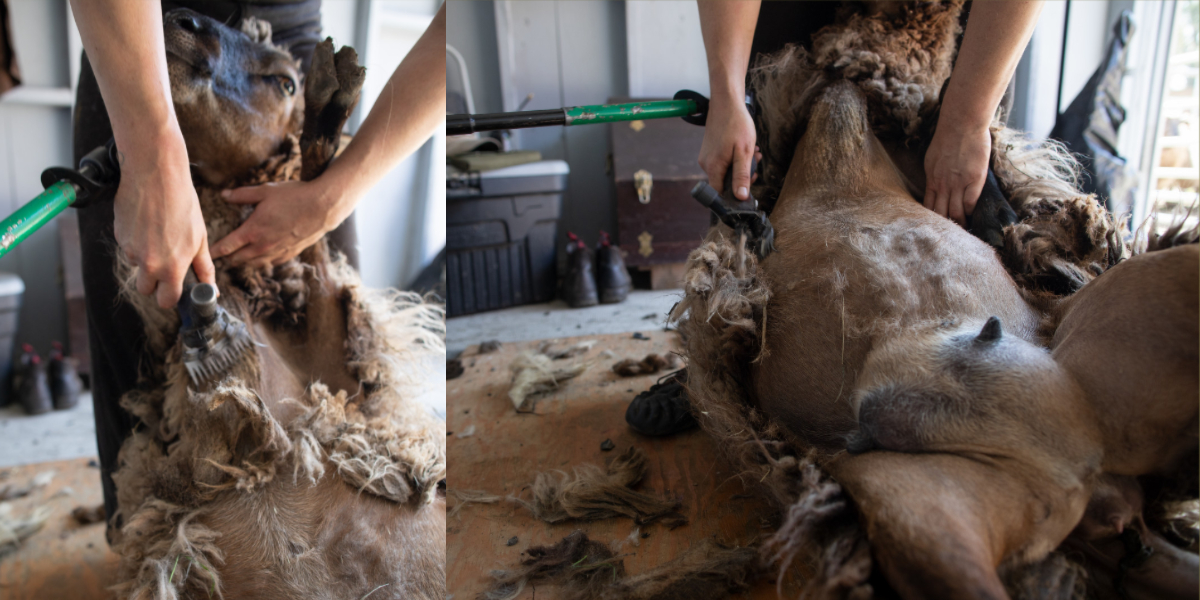
The shearer continues to shear around the hind legs, moving with the sheep and supporting its back and shoulders as they go.
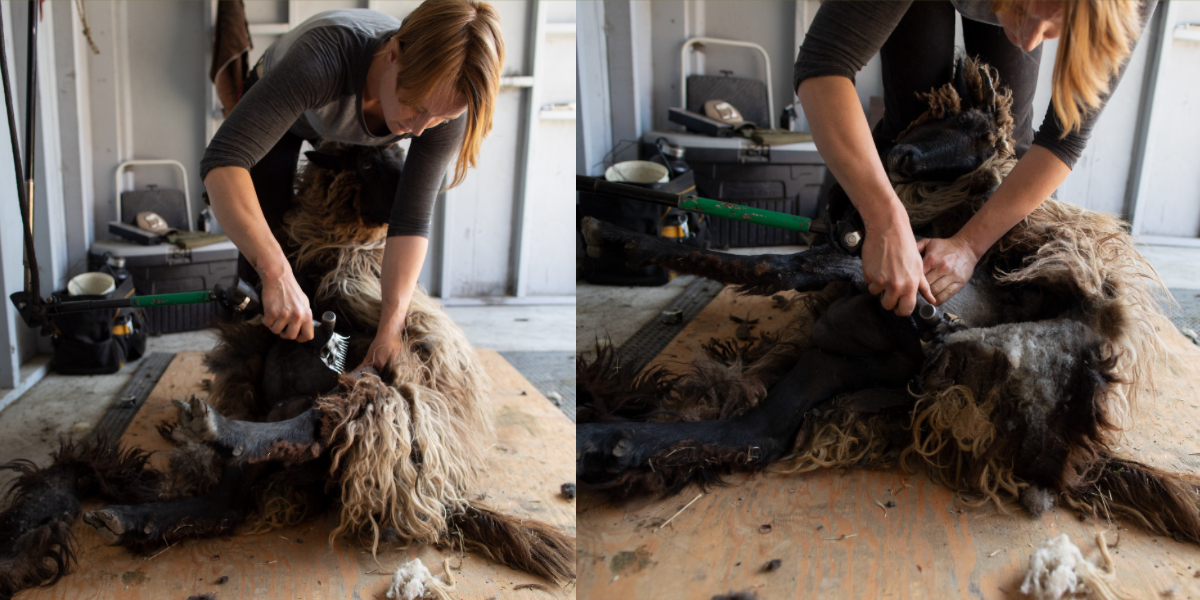
Shearing the neck can be delicate, and requires an amount of muscle memory and practice in order to feel where the sheep’s neck is without being able to see it for all the wool. The shearer holds the sheep’s jaw and nose to direct the smooth movement of the shearing blade along the neck and up under its chin safely.
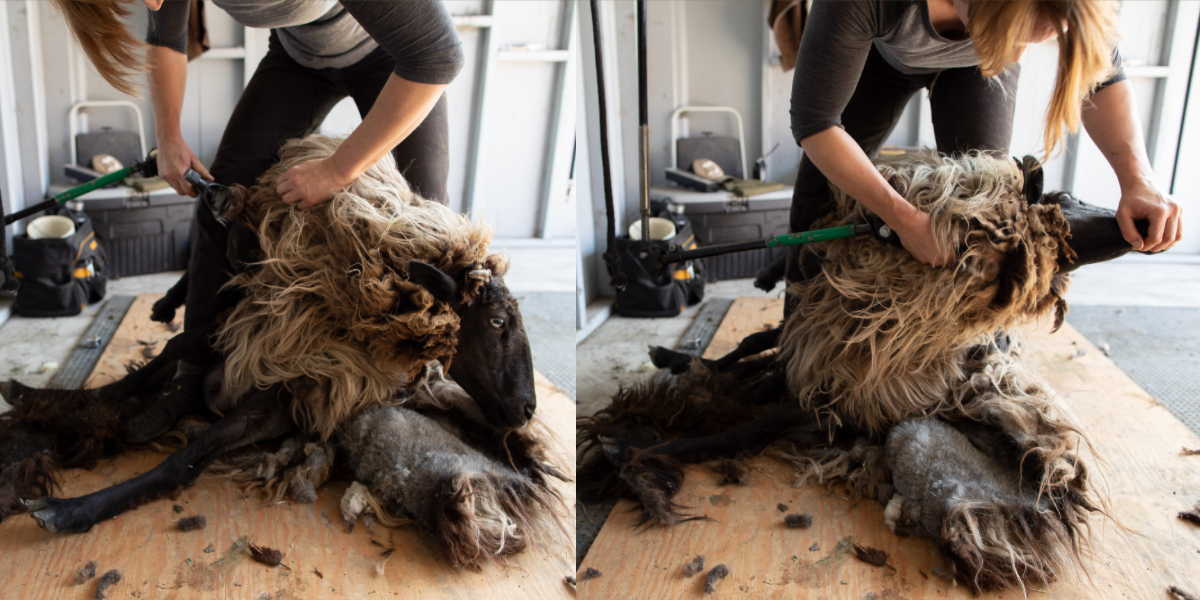
After the neck, the shearer does a critical move that may seem unremarkable to the average viewer: they take a tiny step back with their right foot, swinging the sheep’s hips around with them as they go and switching the direction of the spinal S-curve. This movement is key to lying the sheep down on the ground in a comfortable, low stress, smooth and efficient way. It is subtle and elegant. From here, the shearer can easily shear the shoulder, armpit, flank and back of the sheep, while keeping their own feet and legs entangled with the sheep’s feet and legs in a manner that lets them keep the sheep comfortable and stable, while avoiding being kicked by sharp hooves. Avoiding being kicked in the shins is important to shearer health and endurance.
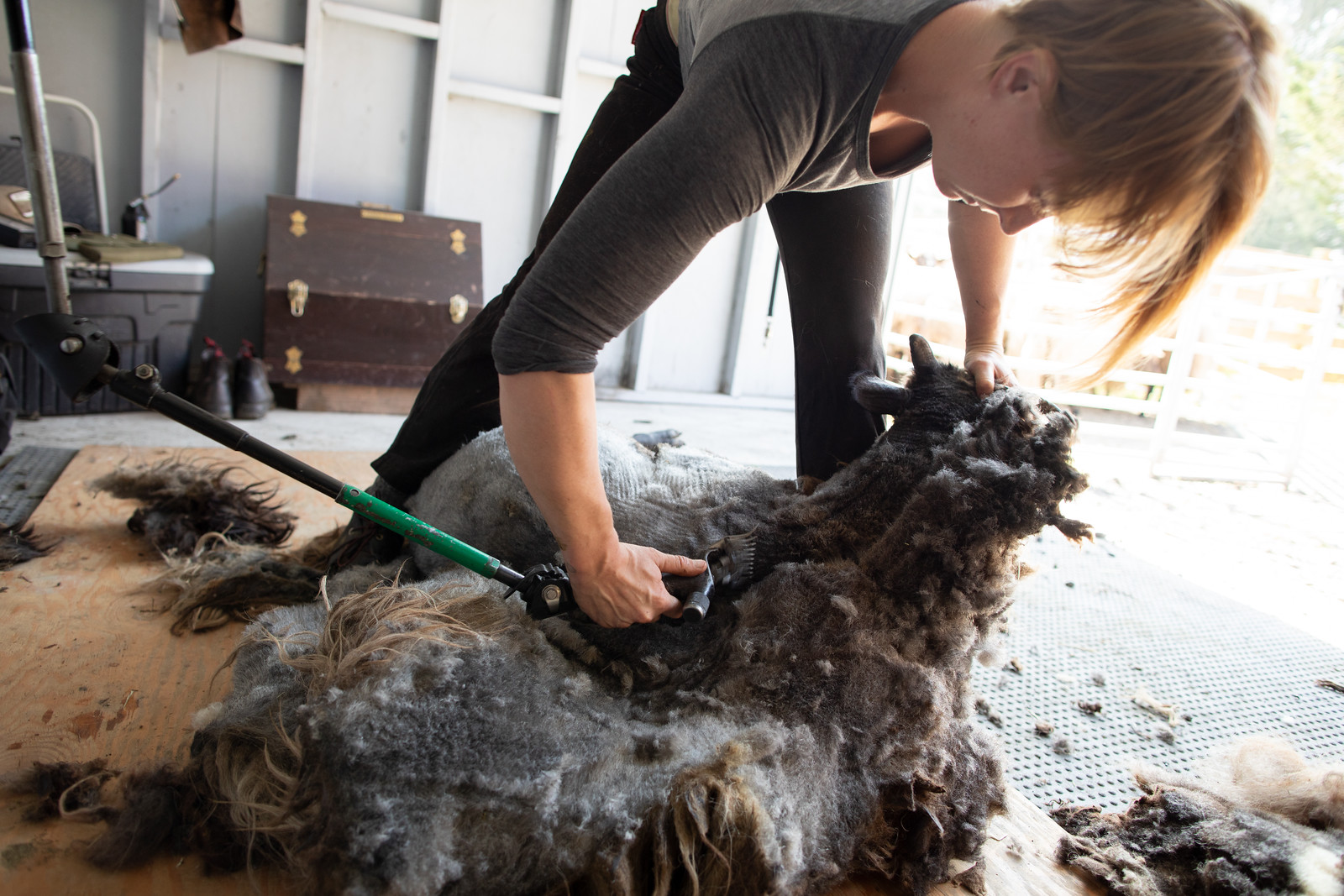
When the shearer gets to the very last shearing motion on the back, they step their right foot over the sheep, to support its lower back and to be able to reach all the way up the back, along the neck, and to the ear. Next, in what seems like a magic trick to new shearers, as they work their way up the back of the neck and head, and then slowly down the other side of the neck, shoulder, and flank, the sheep rolls right back up into its sitting, stacked up, S-curved spine position. Experienced shearers do this movement absolutely effortlessly, though it seems to defy the laws of gravity given the weight of the animal.
From there, the shearer works their way back down the side and back of the sheep, with the sheep’s head comfortably resting between the shearer’s legs. Of all the positions, this one seems to be the most calming to the sheep. When the shearing is done, the sheep is lying on its side, head between the shearer’s feet. Sometimes the sheep stay there and rest for a minute, sometimes they scramble up immediately and scamper between the shearer’s legs. They go immediately out the barn door or down the chute, to the pen where the other shorn sheep are waiting to sniff them and remember who they are now that their wool coat is off.
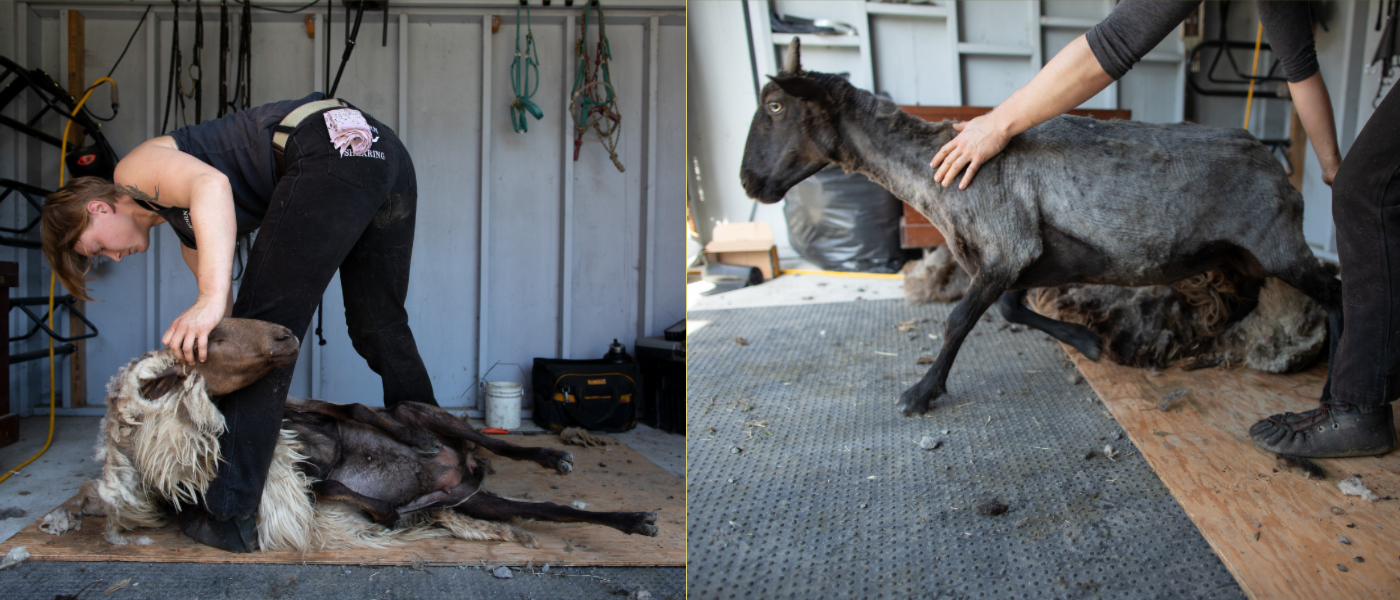
And there you have the anatomy of a sheep shearing choreography. It’s a balance between sheep, person, and tool, with very precise positions for all three. A professional shearer can do the entire choreography in 1 to 4 minutes, while leaving the fleece perfectly intact for skirting and spinning. An intact fleece stays in exactly the same formation as it was on the sheep, forming a blanket that can be parted out by the shoulder, the legs, the back, and the neck. While a wool handler picks up the fleece, the shearer is busy getting another sheep, to flip and repeat the shearing dance again. Professional shearers usually perform their shearing dance about 100 times a day, shearing 100 sheep per day.
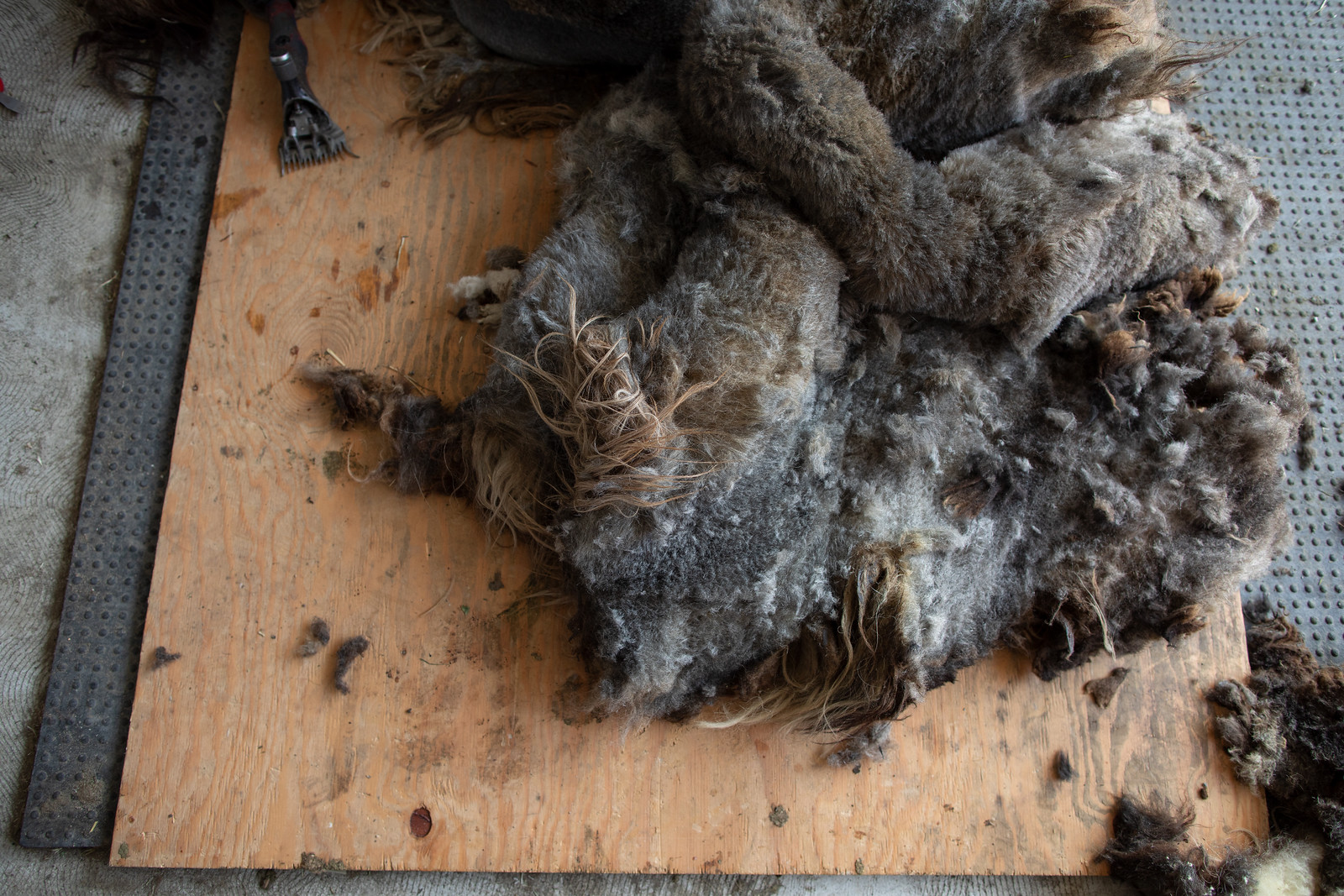
Shearing can be exhausting and it can be exhilarating. There is a shortage of shearers available to do this necessary yet fulfilling work, despite the fact that most shearing schools have waitlists, and the program by UC Cooperative Extension Sheep Shearing at the UC Hopland Research and Extension Center was so popular that in 2019 it sold out in 2 minutes. Because you don’t need to own sheep or land in order to work as a shearer, shearing is becoming more popular amongst people from urban backgrounds who want to engage more with agriculture. Economically, socially, and politically, the divide between urban and rural has become such a challenge that younger people from urban backgrounds are looking for ways to connect back to the land through agriculture. Shearing student Kyle Lawson hopes that becoming a sheep shearer will help him to “be part of a movement that helps bridge urban and rural communities.” Shearing sheep provides one of these opportunities for reconnection.
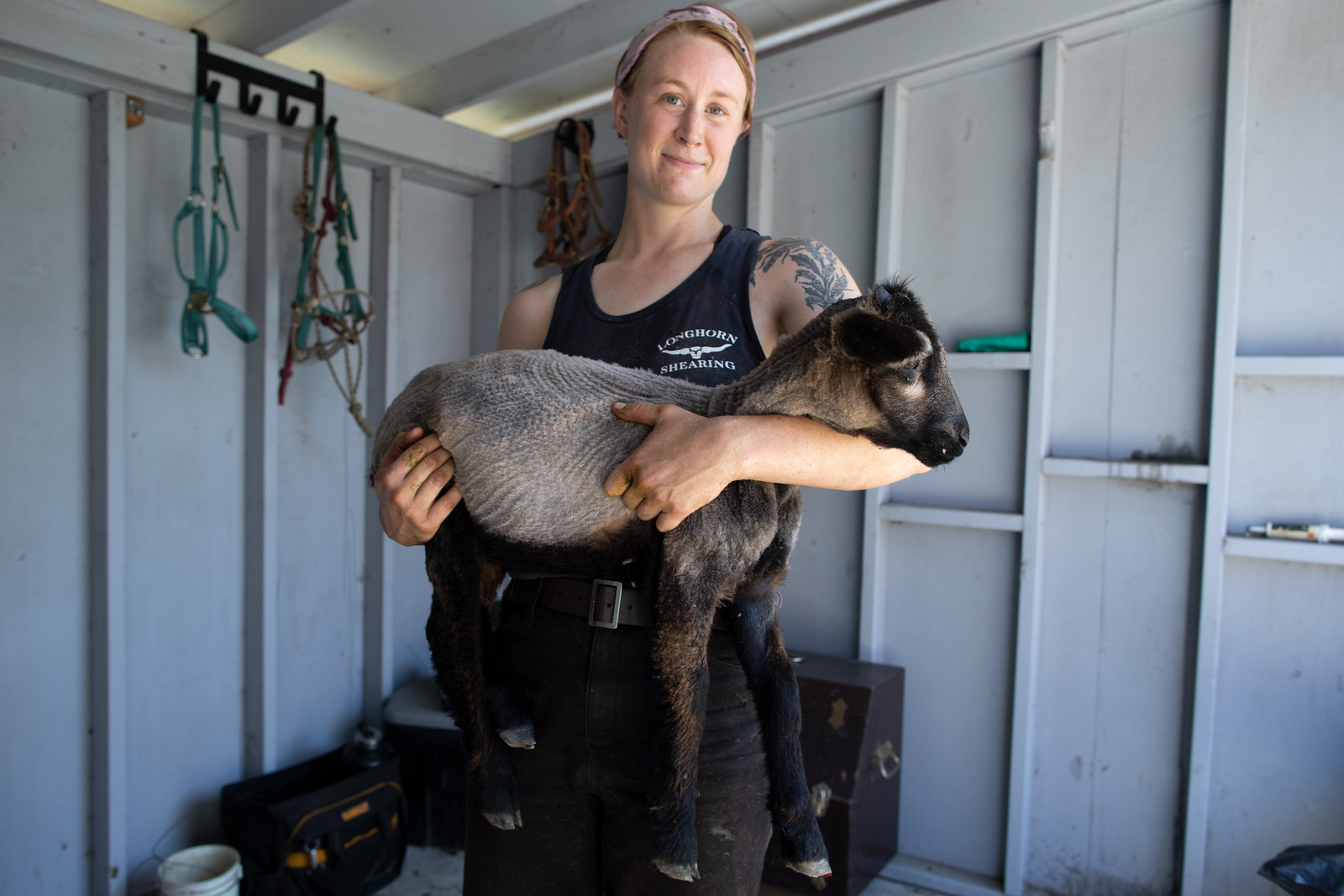
Shearing, whether using the more modern motorized unit and Bowen Technique or the more old-fashioned hand clippers and a stanchion, is more than simply standard healthcare for sheep, and more than harvesting wool for clothing and bedding. It offers a human way of connecting with the animals that clothe us, in an intricate choreography that demands precision as much as it demands respect.
This was the last installment of a three-article series on sheep shearing and animal welfare. To read the previous installments, click here and here.

